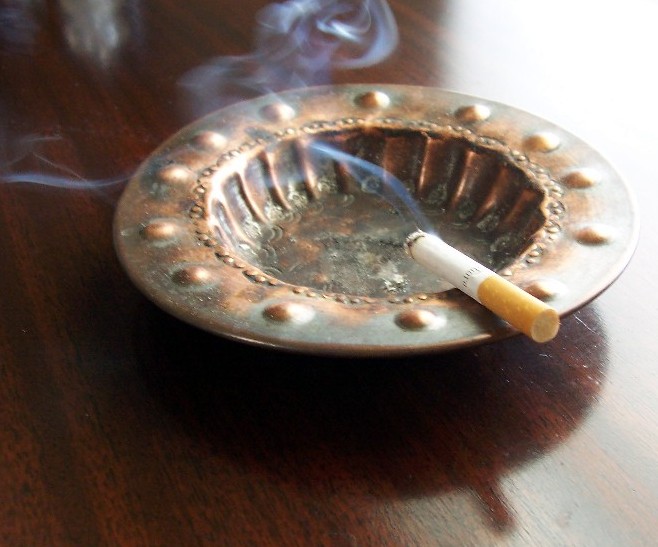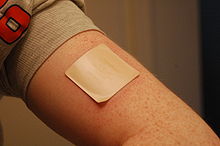Smoking cessation (colloquially quitting) is the process of discontinuing the practice of inhaling a smoked substance. Smoking cessation programs mainly target tobacco smoking, but may also encompass other substances that can be difficult to stop using due to the development of strong physical addictions or psychological dependencies resulting from their habitual use. This article focuses exclusively on cessation of cigarette smoking. However, the methods described may apply to cessation of smoking other substances.
It is believed that very few smokers can successfully quit the habit in their very first attempt. Many studies indicated that many smokers find it difficult to quit, even after they get afflicted with tobacco related diseases. A serious commitment and resolve is required to arrest nicotine dependency.
- In a growing number of countries, there are more ex-smokers than smokers. (In the U.S. as of 2010, 47 million ex-smokers and 46 million smokers.)
- Up to three-quarters of ex-smokers have quit without assistance (“cold turkey” or cut down then quit), and unaided cessation is by far the most common method used by most successful ex-smokers.
 A serious attempt at stopping need not involve using nicotine replacement therapy (NRT) or other drugs or getting professional support.
A serious attempt at stopping need not involve using nicotine replacement therapy (NRT) or other drugs or getting professional support.- Early “failure” is a normal part of trying to stop. Many initial efforts are not serious attempts.
- NRT, other prescribed pharmaceuticals, and professional counselling or support also help many smokers, but are certainly not necessary for quitting.
Tobacco contains the chemical nicotine. Smoking cigarettes leads to a dependence on nicotine. Cessation of smoking leads to physiological symptoms of withdrawal. Methods of smoking cessation must address this dependency and subsequent withdrawal symptoms.
Preparation
First, you need to start preparing yourself. Getting into the right mind set to stop smoking is very important. You have to be focused on what you are doing, why you’re doing it and how you’re doing it. Having all this sorted out will make sticking to the program much easier. The good news is all this takes just two steps.
.jpg/800px-Flickr_-_boellstiftung_-_Konferenzeindr%C3%BCcke_(15).jpg) Step 1: Decide why you want to quit smoking and write those reasons down – all of them. If you get stuck, think about headings like Health, Looks, Finances, Family, Things I’ll be able to do. Now copy these reasons onto another piece of paper headed ‘What Will Happen When I’ve Stopped Smoking’, but change the wording of any negative statements into something positive. For example, if you’ve written ‘I won’t have to spend money on cigarettes’, change that to ‘I will have extra money to spend on anything I like’. Or, if one of your reasons is ‘I won’t cough every morning’, change that to ‘My lungs will feel healthier and less congested’. It may sound strange, but, psychologically, positive thinking is usually much more effective than negative. Every morning, read that piece of paper and focus on each of the statements.
Step 1: Decide why you want to quit smoking and write those reasons down – all of them. If you get stuck, think about headings like Health, Looks, Finances, Family, Things I’ll be able to do. Now copy these reasons onto another piece of paper headed ‘What Will Happen When I’ve Stopped Smoking’, but change the wording of any negative statements into something positive. For example, if you’ve written ‘I won’t have to spend money on cigarettes’, change that to ‘I will have extra money to spend on anything I like’. Or, if one of your reasons is ‘I won’t cough every morning’, change that to ‘My lungs will feel healthier and less congested’. It may sound strange, but, psychologically, positive thinking is usually much more effective than negative. Every morning, read that piece of paper and focus on each of the statements.Step 2: Now you need to decide how you are going to stop smoking. There are a few methods that you can use, but three work best with the Stop Smoking Plan.
Methods of smoking cessation
Robert West and Saul Shiffman have authored works on smoking cessation. They believe that, used together, "behavioral support" and "medication" can quadruple the chances that a quit attempt will be successful. Both, however, disclosed that they are paid researchers or consultants to pharmaceutical companies or manufacturers of smoking cessation medications.
Cold turkey
 "Cold turkey" is abrupt cessation of all nicotine use. It is the quitting method used by 80% to 90% of long-term successful quitters in some populations. It’s a good approach, but it’s also the most intense because you will probably suffer strong nicotine withdrawal for 24-48 hours and milder symptoms for a week to ten days. Using the diet detailed over the page will help reduce these, which will make things easier. You should start the diet the day before you decide to stop, then stick to it for at least a fortnight. Also use the controlling cravings tips to help you tackle any urges to smoke that you may develop and keep this up for the next five weeks.
"Cold turkey" is abrupt cessation of all nicotine use. It is the quitting method used by 80% to 90% of long-term successful quitters in some populations. It’s a good approach, but it’s also the most intense because you will probably suffer strong nicotine withdrawal for 24-48 hours and milder symptoms for a week to ten days. Using the diet detailed over the page will help reduce these, which will make things easier. You should start the diet the day before you decide to stop, then stick to it for at least a fortnight. Also use the controlling cravings tips to help you tackle any urges to smoke that you may develop and keep this up for the next five weeks.In a large British study of ex-smokers in the 1980s, before the advent of pharmacotherapy, 53% of the ex-smokers said that it was “not at all difficult” to stop, 27% said it was “fairly difficult”, and the remainder found it very difficult. Methods advanced by J. Wayne McFarland and Elman J. Folkenburg (an M.D. and a pastor who wrote their Five Day Plan in about 1959), Joel Spitzer and John R. Polito (smoking cessation educators whose work is free at WhyQuit.com) and Allen Carr (who founded Easyway® during the early 1980s) are cold turkey plans.
Cut down to quit
 Gradual reduction involves slowly reducing one's daily intake of nicotine. This can be done in two ways: by repeated changes to cigarettes with lower levels of nicotine, or by gradually reducing the number of cigarettes smoked each day. As of 2010, and unlike earlier studies who claimed some benefit for gradual reduction, a Cochrane review found that abrupt cessation and gradual reduction with pre-quit NRT produced similar quit rates.
Gradual reduction involves slowly reducing one's daily intake of nicotine. This can be done in two ways: by repeated changes to cigarettes with lower levels of nicotine, or by gradually reducing the number of cigarettes smoked each day. As of 2010, and unlike earlier studies who claimed some benefit for gradual reduction, a Cochrane review found that abrupt cessation and gradual reduction with pre-quit NRT produced similar quit rates.Many experts say this is one of the hardest ways to give up smoking because it just prolongs your addiction. However, if you’re afraid of withdrawal, it can give you a safety net. If you’re going to use this method, you’ll be on the diet for five weeks. While you do this, you should aim to reduce the number of cigarettes you smoke progressively by one-fifth per week. For a 20-a-day smoker, this means either reducing your intake by four cigarettes a day for the whole week (that is, reduce to 16 per day for the first week, 12 per day for the second week, and so on), or cutting down progressively by one cigarette a day on the first four days of the week (that is, 19 on Monday, 18 on Tuesday, 17 on Wednesday, 16 on Thursday, stay at that level for Friday to Sunday, then start reducing again on Monday).
Start with the cigarettes you feel you need most first because if you can break the habit of these, while you have the safety net of being able to smoke if you want one, it’s going to be much easier when you get to the last week. Also use the controlling cravings tips to keep you from lighting up when you shouldn’t.
Pharmacological
The U.S. Food and Drug Administration has approved seven medications for treating nicotine addiction. All of these helped with withdrawal symptoms and cravings.
Nicotine replacement therapy (NRT) Five of the approved medications are different methods of delivering nicotine in a form that does not involve the risks of smoking. The five NRT medications, which Cochrane found in 1996 increased the chances of stopping smoking by 50 to 70% compared to placebo or to no treatment, are:
1) transdermal nicotine patches deliver doses of the addictive chemical nicotine, thus reducing the unpleasant effects of nicotine withdrawal. These patches can give smaller and smaller doses of nicotine, slowly reducing dependence upon nicotine and thus tobacco. Cochrane found further increased chance of success in a combination of the nicotine patch and a faster acting form. Also, this method becomes most effective when combined with other medication and psychological support.
3) lozenges
4) sprays
5) inhalers
A study found that 93 percent of over-the-counter NRT users relapse and return to smoking within six months. If you are using NRT, the controlling cravings section is the most important part of the plan for you. Use NRT for as long as you need; then, as you start to come off it, you should begin to use the diet to help you beat the withdrawal symptoms that will occur.
Alternative medical approaches
- Hypnosis clinical trials studying hypnosis as a method for smoking cessation have been inconclusive although many people have successfully quit smoking using hypnosis and hypnotherapy.
 Aromatherapy based treatments and herbal preparations such as Kava and Chamomile, the efficacy of which has not been established.
Aromatherapy based treatments and herbal preparations such as Kava and Chamomile, the efficacy of which has not been established.- Acupuncture clinical trials have shown that acupuncture's effect on smoking cessation is equal to that of sham/placebo acupuncture.
- Laser therapy based on acupuncture principles but without the needles.
Reference: http://en.wikipedia.org/wiki/Smoking_cessation
Images: http://commons.wikimedia.org/wiki/












0 comments:
Post a Comment